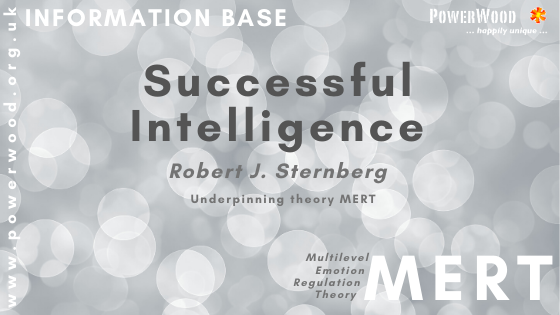Underpinning theory
The Theory of Successful Intelligence what now is called the Triarchic theory of intelligence is one of the underpinning theories of the Authentic Communication Model (ACM) which is one of the main concepts of the holistic Multifaceted Emotion Regulation Theory (MERT) developed by Simone de Hoogh for (more)able neurodiverse children, teens and (young) adults.
The Multifaceted Emotion Regulation Theory (MERT) explains how neurodiverse (young) individuals and parents of neurodiverse children can develop emotional regulation skills and direct their energy towards self-chosen goals, and create a more harmonious fulfilling (family) life.
The parts of intelligence
The Triarchic theory of intelligence is a well-known theory of intelligence created by Robert J. Sternberg, an American psychologist and unlike most theories of intelligence, Sternberg’s theory calls for the integration of intelligence and creativity. Sternberg mentions practical intelligence (common sense) and creative intelligence) as the defining factors in achieving our personal goals in life.
Sternberg’s definition of successful intelligence
Successful intelligence is defined as one’s ability to set and accomplish personally meaningful goals in one’s life, given one’s cultural context.
A successfully intelligent person accomplishes these goals by figuring out his or her strengths and weaknesses, and then by capitalizing on the strengths and correcting or compensating for the weaknesses. Strengths and weaknesses are in terms of four kinds of skills: creative, analytical, practical, and wisdom-based. In particular, the individual needs to be creative in order to generate novel and useful ideas; analytical to ascertain that the ideas he/she has (and that others have) are good ones; practical in order to apply those ideas and convince others of their value; and wise in order to ensure that implementation of the ideas will help ensure a common good through the mediation of positive ethical principles. (Source)
What makes us intelligent?
So what makes a person intelligent? According to Sternberg, intelligence cannot be defined by intelligence tests such as the Stanford-Binet scales. Rather, intelligence should be defined in terms of how you perform in your everyday world.
Sternberg refers to what he calls successful intelligence. People who are successfully intelligent are able to define and achieve their own idea of success within their culture. People who are successfully intelligent are skilled at adapting to and modifying their environment to fit their needs. Because your intelligence is highly dependent upon the culture that you live in, an individual that is considered intelligent in one culture might not be considered intelligent in another.
There are four components of successful intelligence: analytical, creative, practical intelligence, and wisdom or emotional intelligence. It is not enough to possess the components. One must also know when and how to use these components in order to be effective and responsible.
Analytical Intelligence
Have you ever been called ‘book smart?’ If so, you were being complimented on your analytical intelligence. Analytical intelligence, also called componential intelligence, refers to your ability to problem-solve, process information effectively, and complete academic tasks. People with high analytical intelligence perform well on traditional IQ tests (i.e., Stanford-Binet scales), college admission exams (i.e., Scholastic Assessment Test), and school exams (i.e. math quizzes). They are skilled at critical thinking and analytical thinking. People with high analytical intelligence can examine problems from multiple points of view.
Creative Intelligence
Creative intelligence is our ability to call upon existing knowledge and skills to effectively handle new and unusual situations. Because creative intelligence involves using past experiences, it is also called experiential intelligence. People with high creative intelligence have great insight, imagination, and are able to formulate new ideas. For example, painters are often able to use their imagination to paint original artwork. Unlike analytical intelligence, creative intelligence is often overlooked by intelligence tests.
Practical Intelligence
Practical or contextual Intelligence is our ability to translate analytical insights and creative expressions into a form that helps to adapt to the environment or form it in such a way that it helps us to achieve our own chosen goals in life. Through the three processes of adaptation, shaping, and selection, individuals create an ideal fit between themselves and their environment. This type of intelligence is often referred to as “street smarts.”
PowerWood’s Authentic Communication Model (ACM), part of the Multifaceted Emotion Regulation Theory (MERT, is a very helpful tool in how to effectively communicate with oneself and others, and is partly inspired by this Theory.
Wisdom or Emotional Intelligence
Wisdom (or our emotional intelligence) is our ability to know when to apply which ability to achieve our goals in our own community. While ensuring that our ideas will help enrich our community and even the world we live in as an empowering, respectful and responsible contribution according to our personal and communal norms and values.
Further reading
Augmented Theory of Successful Intelligence
Sternberg, R. J. (1996). Successful intelligence, How practical and creative intelligence determine success in life. New York: Simon & Schuster.

